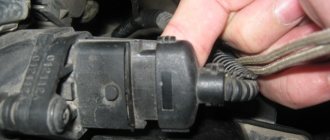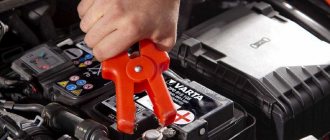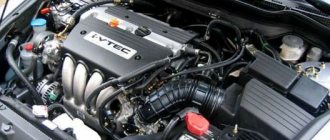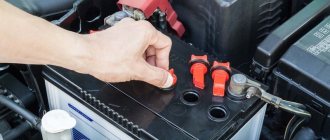Wake up the battery
Do not start the engine immediately. The battery needs to be prepared. Long downtime is not good for the battery, especially if it has been working on the machine for more than five years. The battery loses charge and is not always ready to instantly replenish the load from many electronic systems. As a result, errors occur that affect the operation of the electronics. Therefore, you must first cheer up the battery. To do this, before starting the engine, you can turn on the high beam headlights for a couple of seconds by pulling the steering column lever towards you. Three or four blinks will trigger chemical processes in the battery that will allow the battery to prepare for operation.
Article on the topic Freeze in place. How does prolonged downtime affect a car? Next, turn the ignition key in the lock and leave it in the second position for a few seconds. The fuel pump will pump gasoline, and the electronics will diagnose the performance of the machine’s systems, set the correct mixture, after which the power unit can be started. If the car is started with a button, then to activate the ignition, press it twice without pressing the brake pedal with your foot.
How long can a car sit in one place?
In reality, this “parameter” is influenced not by the length of time the car is idle, but by all external factors that can negatively affect the condition of the car. This is why, after months or years of improper storage in one place, corrosion appears on the car sills.
It is also important to remember that a machine is a complex high-tech device that consists of a wide variety of components and elements. And, if these components remain idle for too long without proper care, then the machine may completely lose its operational properties.
Now let’s imagine this situation: a person has arrived, say, after a long business trip and wants to start his car, which has been parked in an open parking lot for the last 1.5 years. What might he encounter? That's right - the car simply won't start.
The oil must be pumped
It is not recommended to drive immediately after the start. Over several weeks of inactivity, the oil has completely drained from the working surfaces of the friction pairs into the crankcase, and it takes time for the oil pump to pump it again through the complex labyrinths of the lubrication system. If you start accelerating in the first second and immediately hit the road, and even apply the gas to feel the power of the engine, then there is a high chance of ruining it through inept actions. Scores may appear on the cylinder walls. This occurs when the piston rings break through the oil film and touch the cylinder lining under load. Scratches appear through which oil seeps into the chambers, burns there and is released through the exhaust system into the atmosphere in the form of dark or bluish smoke. This is a death sentence for the motor. Scuffs can be repaired only by grinding the walls and re-honing.
To avoid scoring, you need to wait about 3 minutes while the oil pump passes 4 liters of oil through the lubrication system and filters out the caked sediment. Then you can slowly set off on your journey.
Disservice. What car systems reduce engine life? More details
Checking technical fluids
It is also necessary to carefully check the level and condition of all technical fluids: engine oil, brake fluid, power steering fluid (power steering), transmission oil level (if possible), cooling system coolant level in the expansion tank. All fluids must be filled in full before starting. A decrease in level or an empty tank will indicate a malfunction in the form of leaking pipes, gaskets, seals, etc. It is worth checking the fluids most closely in the most important components (engine oil, cooling system, fuel system).
Engine oil condition
Motor oil tends to age not only with mileage, but also with time. The shelf life of the lubricant that is poured into the engine is very limited and is about 12 months. Moreover, if the engine is in operation, the additive package tends to mix with the base. When a car sits for a long time, the additives settle and the oil simply separates. For this reason, it is necessary to evaluate the condition of the lubricant.
If the oil is very thick, black, and contains impurities and debris, then it is better not to start the engine. This oil is drained, after which the flushing composition is poured. Next, you can add fresh lubricant and replace the oil filter.
Fuel in tank
Gasoline or diesel fuel tends to accumulate moisture (condensation). If the car is prepared for parking in advance, then the tank is 2/3 filled with high-quality fuel, which must be drained before starting. As for unprepared vehicles, there is a high probability that there will be spoiled fuel in the fuel tank, which must be drained.
Coolant
To check, just unscrew the cap of the expansion tank and assess the condition of the coolant. If the level is within acceptable limits, there are no visible “flakes” or other contaminants, then you can drive several kilometers on such a liquid, carefully monitoring the engine temperature. Next, the fluid will need to be changed, after flushing the cooling system.
Brake fluid
One of the properties of brake fluid is hygroscopicity, which means the accumulation of moisture. Under normal conditions, brake fluid is changed once every two years. If the car has been sitting for a long time, then before the first trip the fluid is drained and the brakes need to be bled.
Next, be sure to check the brake pads and brake discs themselves. Loose linings on the pads make them unsuitable for further use.
If the brake discs are covered with rust, then when starting to move, lightly hold your foot on the brake, thus driving several tens of meters. The rust must be removed.
Transmission needs to warm up
When an old car, well over a dozen years old, is equipped with a manual transmission, you need to start the engine after idle time only at neutral speed. If you leave the box in gear and crank the starter with the clutch depressed, there is a high risk that during a month of inactivity the friction discs have become stuck to each other, have not opened, and the transmission will receive a blow from the output shaft of the power unit. Neutral speed will allow you to warm up the engine and gearbox before starting to move, and the clutch discs will open more easily after several repeated presses of the pedal.
An automatic transmission requires a different approach. In the first seconds of engine operation, an additional pump in the transmission also pumps transmission oil through the complex labyrinths of the box. And this requires about two minutes of idling. Therefore, it is necessary to wait until the transmission is in working condition.
How to prepare a car for starting after a long period of inactivity
There are a few key things to pay attention to after your car has been sitting for a long time. Let's consider each of them separately.
Accumulator battery
The first thing you need to find out is whether the battery was removed from the car before it was idle. If the battery is installed under the hood of your vehicle, it will most likely need to be replaced or charged.
If the terminals were not removed from the battery before the vehicle was parked, the battery is most likely discharged. If the car has been left in this condition for up to a year, you can try to restore the battery by charging it. If the car has been sitting for more than a year, a new battery will most likely be needed.
Checking and replacing technical fluids
The second stage of checking a car that has been sitting idle for a long time is replacing technical fluids. There are quite a lot of them in the car, and before starting you need to make sure that all the fluids are present in the required volume and they have not lost their quality.
Check the following technical fluids:
- Engine oil. Modern motor oil can remain in a car without losing its properties without load for about a year. That is, if the car has been parked for more than 12 months and it is filled with engine oil, it will need to be drained and replaced with new one. When there is no information about how long the car has been parked, you can check the oil visually. If the technical fluid is black, thick and contains contaminants or signs of additive detachment, it must be replaced before starting the engine. Of course, the process of changing engine oil should also be accompanied by replacing the oil filter;
- Fuel in the tank. If the car was not drained of fuel before parking for a long time, this must be done before starting the engine for the first time, and then fill it with new fuel. This is due to the fact that when parked, especially on the street, gasoline and diesel accumulate moisture, which is released. It is strictly not recommended to start the engine with old fuel that has been in the tank for more than six months;
- Brake fluid. Another technical liquid that requires attention due to hygroscopicity, that is, the accumulation of condensate. Typically, brake fluid is changed about once every 24 months. But if the car has been sitting for more than a year, it will need to be replaced. After draining the fluid, bleed the brakes and also check other elements of the brake system for wear: pads, brake discs;
- Coolant. This technical fluid is checked visually. Unscrew the cap of the reservoir where the coolant is filled and inspect it. If “flakes” have formed on the surface of the liquid, it must be drained and replaced with a new one before starting the engine for the first time. If there are no “flakes”, you can try to start the engine with the existing coolant, but then it is important to control the temperature of the engine itself.
Listed above are only the main technical fluids that need to be checked. It is also recommended that before the first start, make sure that there is power steering fluid, that there is oil in the gearbox and other systems where it should be present.
Visual inspection of vehicle parts
Before starting the engine for the first time after a long period of inactivity, it is necessary to visually inspect the vehicle parts. Make sure there are no cracks in the rubber elements, pipes, or hoses of the main components.
The average lifespan of rubber products used in a car is 3-4 years without load. That is, if the car has been parked for longer than this period, you should be especially careful about this element of the check.
Also, do not forget to inspect, check, and, if necessary, replace the spark plugs (for a gasoline engine) or glow plugs (for a diesel engine).
No jumping
Once you start driving, you should not allow the car to “jump” over bumps. The fact is that the oil in the shock absorbers has also settled, and they require a delicate attitude. If you carefully drive through several potholes and bumps at speeds below 20 km/h and continue to follow the road without strong impacts on uneven surfaces and without swaying on the asphalt waves, the shock absorbers will quickly warm up and after a couple of hundred meters they will be able to handle obstacles painlessly.
Question answer
Do “million dollar cars” really exist? However, during active drive immediately after the start, uneven oil in cold shock absorbers can cause pressure concentration in local areas, which leads to damage to the gaskets. The shock absorber will simply leak.
In general, these actions do not require time and financial resources, but they significantly save car owners money on possible repairs.











